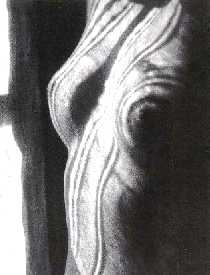 |
Réalisation: Man Ray
Actor: Kiki of Montparnasse (La femme nue)
Time: 3; NB, no sound
Aka: Return to Reason
--------------------------------------------------------------------------------
One day in July 1923, Tzara brings to Man Ray a placard announcing a major event Dada, Le Coeur à Barbe, to be held the following evening at the Théâtre Michel; the poster said that Man Ray will present a film. The artist may say that he has no film that some already turned seqauences barely lasts a minute, and there is no time to do more, Tzara replica a projector and an operator is already selected, and must be anyway present something. It will even suggest that the technique of "rayographs" - photographic compositions produced without a camera, exposing objects directly on sensitive paper - could be applied to the film stock. Man Ray acknowledges that this is possible, and promises to try to prepare images for the next day.
I procured a roll of film of about thirty meters, settled myself in my darkroom, where I cut the film into small strips épinglai I knew my desk. I saupoudrai few strips with salt and pepper, as a cook prepares his roast. On the other bands I threw at random pins and tacks. I then expounded to white light for a second or two, as I had done for his rayographs, inanimate.
Then I removed the film carefully from the table, threw off debris at développai the film in my tanks. The next morning I examined my work, which in the meantime had dried. Salt, pins and tacks were perfectly reproduced in white on black as the shelves of clichés X. But the different images were not separated as in an ordinary film. What would happen on the screen? I had no idea. I also did not know you could montert film with tape, so I just glued the strips together.
I atoutai, in the end, to prolong film, some footage that I had toiurnées with the camera. But the projection would only last three minutes. Whatever happens, I thought, it's over before the audience has time to react.
The program included other numbers for testing the patience of the audience: what was the main purpose of the Dadaists.
I entered the theater a few minutes before the curtain, brought it my film to Tzara and tell him that he should present it, because he had no subtitles or captions. I called the film "Retour à la raison" (Return to reason).
Man Ray's film is a reminder that the cinema is twenty something images per seconds, married to a celluloid film. Reason shows us that reality is illusion.
The pioneering spirit in which the film is impregnated remains highly relevant fact: in the words attributed to Man Ray Tristan Tzara: "it was time to do something (against) all the silliness that abounded on screens "...
Excerpts from Man Ray, directeur du mauvais movies, Jean-Michel Bouhours (Editions du Centre Georges Pompidou, 1997)
|
